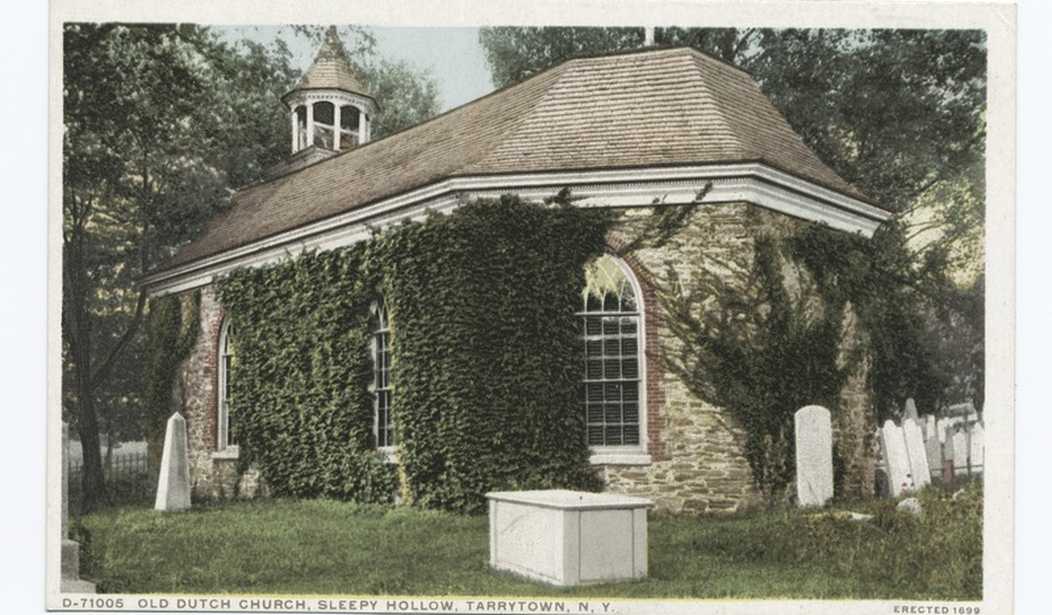Today is Halloween, a day for trick-or-treating, dressing up, hosting parties — and telling ghost stories. The most famous American ghost story is that of the Headless Horseman of Sleepy Hollow. What do Halloween, Walt Disney, and the American Revolution all have in common? The eerie legend of the galloping Hessian of the Hollow, forever seeking a head to replace the one he lost.
If you go to the village of Tarrytown, N.Y., still today, as I did last year, you can see the Old Dutch Church and cemetery, which the Headless Horseman once haunted (the tombstones filled with the names in Irving’s legend), the woods that British spy John Andre supposedly haunted after the Americans hanged him, and Washington Irving’s home. The little village once isolated and frozen in time, which so charmed Irving, is famous because it inspired the quintessential American ghost story: Irving’s “Legend of Sleepy Hollow.”
Last week was the anniversary of the Battle of White Plains (Oct. 28, 1776), a discouraging defeat for George Washington and the American Revolutionaries — a battle that took place only a few miles from Tarrytown. But it also seems to have given birth to a legend. The New-York Historical Society notes that among the possible influences behind Irving’s story, including the German folklore of “The Wild Huntsman,” is a piece of information in Maj. Gen. William Heath‘s memoir. “A shot from the American cannon at this place [White Plains] took off the head of a Hessian artillery man,” Heath noted. Now notice with whom Irving identifies the Headless Horseman in the passage below, from the “Legend of Sleepy Hollow”:
It is said by some to be the ghost of a Hessian trooper, whose head had been carried away by a cannon-ball, in some nameless battle during the [R]evolutionary war; and who is ever and anon seen by the country folk, hurrying along in the gloom of night, as if on the wings of the wind…he sometimes passes along the Hollow, like a midnight blast.
To this little Dutch town, with its old-fashioned manners and the “sway of some witching power,” came Ichabod Crane the schoolmaster. Irving describes Crane in his tale as an “odd mixture of small shrewdness and simple credulity,” a man who would spend hours reading over and over Puritan Cotton Mather’s history of New England Witchcraft. He spent “long winter evenings with the old Dutch wives… and listen[ed] to their marvelous tales of ghosts and goblins, and haunted fields, and haunted brooks, and haunted bridges, and haunted houses, and particularly of the headless horseman, or galloping Hessian of the Hollow, as they sometimes called him.”
Crane’s other fascination, besides ghosts, is the beautiful and prosperous Katrina Van Tassel. Unfortunately, here he comes in contact with a rival who is anything but supernaturally insubstantial: Brom Van Brunt or “Brom Bones,” “the hero of the country round, which rang with his feats of strength and hardihood.” As Crane cleverly makes himself a frequent guest at the Van Tassel residence, Brom Bones vows vengeance.
Matters come to a head at a party hosted by Balt Van Tassel, Katrina’s father, a frolic full of pretty girls, delicious food, and dancing. Brom Bones, jealous of Ichabod’s rousing success as a dancer, joins in the telling of ghost stories by asserting that he had met the Headless Horseman and even challenged him to a race — which Brom asserts he won. “It was the very witching time of night” when Ichabod Crane set out home, when, upon reaching the very haunted stream where John Andre was captured, Ichabod sees “a horseman of large dimensions, and mounted on a black horse of powerful frame” — and headless!
The Headless Horseman, “gigantic in height, and muffled in a cloak,” rides alongside the terrified Crane, who with his old horse attempts a mad dash past the old church to outrun the frightful apparition. Brom Bones had said the apparition vanished at the old bridge, and Ichabod dashes across the bridge — only to see the dreadful Hessian hurling his severed head toward the petrified schoolmaster! “Ichabod endeavored to dodge the horrible missile, but too late. It encountered his cranium with a tremendous crash — he was tumbled headlong into the dust, and [his horse], the black steed, and the goblin rider, passed by like a whirlwind.”
All that remained the next morning was a shattered pumpkin and Ichabod’s hat. Sure, one farmer claimed Ichabod had simply left in fear and shame and became a justice of the Ten Pound Court, and Brom Bones — the triumphant groom of Katrina Van Tassel — laughed heartily and looked “knowing” when the story was told. But the “old country wives” knew perfectly well, Irving affirmed, that “Ichabod was spirited away by supernatural means.”
Americans, by and large, appear to agree with the old country wives. One American who was fascinated by the Legend of Sleepy Hollow was Walt Disney, who re-popularized Ichabod Crane and the Headless Horseman for new generations in his movie “The Adventures of Ichabod and Mr. Toad.” The Legend of Sleepy Hollow was narrated and sung almost entirely by the great Bing Crosby. It is appropriate that the quintessential American ghost story should have been narrated by the celebrity once known as the “Voice of America.” Here is Bing — or rather, Brom Bones — retelling the legend of the Headless Horseman in song:
Or perhaps you’d rather watch the Horseman himself:
The Headless Horseman is a figure composed of myth, history, superstition, and creative genius. He is our own particular American ghost, and it's a perfect day to celebrate the galloping Hessian of the Hollow.










Join the conversation as a VIP Member